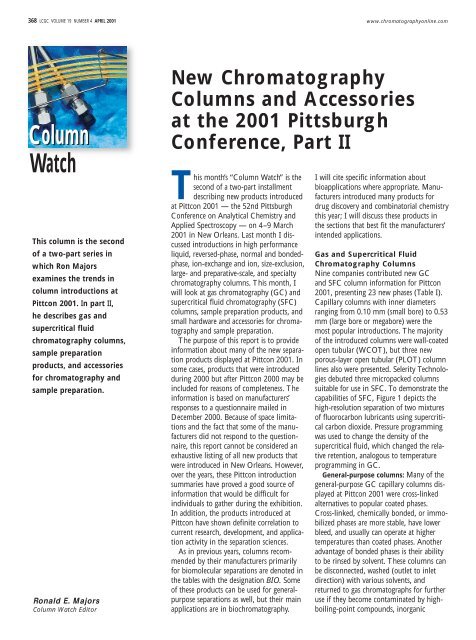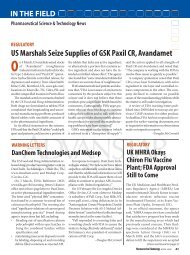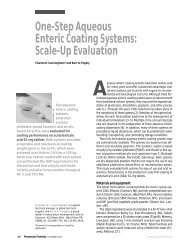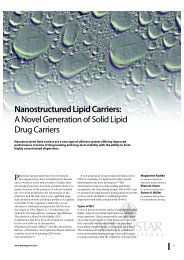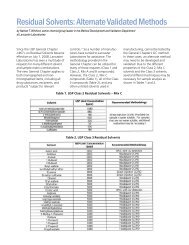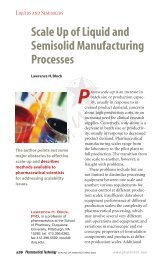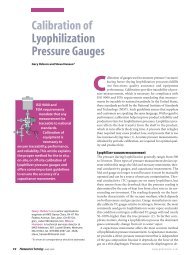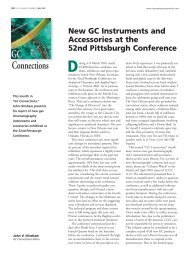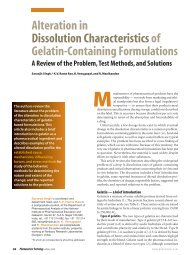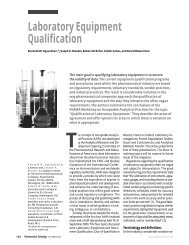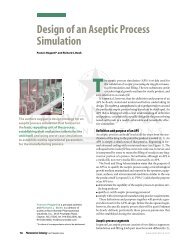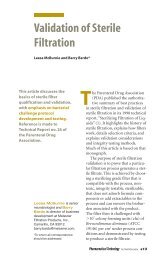New Chromatography Columns and Accessories at the 2001 ...
New Chromatography Columns and Accessories at the 2001 ...
New Chromatography Columns and Accessories at the 2001 ...
You also want an ePaper? Increase the reach of your titles
YUMPU automatically turns print PDFs into web optimized ePapers that Google loves.
368 LCGC VOLUME 19 NUMBER 4 APRIL <strong>2001</strong> www.chrom<strong>at</strong>ographyonline.com<br />
Column<br />
W<strong>at</strong>ch<br />
This column is <strong>the</strong> second<br />
of a two-part series in<br />
which Ron Majors<br />
examines <strong>the</strong> trends in<br />
column introductions <strong>at</strong><br />
Pittcon <strong>2001</strong>. In part II,<br />
he describes gas <strong>and</strong><br />
supercritical fluid<br />
chrom<strong>at</strong>ography columns,<br />
sample prepar<strong>at</strong>ion<br />
products, <strong>and</strong> accessories<br />
for chrom<strong>at</strong>ography <strong>and</strong><br />
sample prepar<strong>at</strong>ion.<br />
Ronald E. Majors<br />
Column W<strong>at</strong>ch Editor<br />
<strong>New</strong> <strong>Chrom<strong>at</strong>ography</strong><br />
<strong>Columns</strong> <strong>and</strong> <strong>Accessories</strong><br />
<strong>at</strong> <strong>the</strong> <strong>2001</strong> Pittsburgh<br />
Conference, Part II<br />
This month’s “Column W<strong>at</strong>ch” is <strong>the</strong><br />
second of a two-part installment<br />
describing new products introduced<br />
<strong>at</strong> Pittcon <strong>2001</strong> — <strong>the</strong> 52nd Pittsburgh<br />
Conference on Analytical Chemistry <strong>and</strong><br />
Applied Spectroscopy — on 4–9 March<br />
<strong>2001</strong> in <strong>New</strong> Orleans. Last month I discussed<br />
introductions in high performance<br />
liquid, reversed-phase, normal <strong>and</strong> bondedphase,<br />
ion-exchange <strong>and</strong> ion, size-exclusion,<br />
large- <strong>and</strong> prepar<strong>at</strong>ive-scale, <strong>and</strong> specialty<br />
chrom<strong>at</strong>ography columns. This month, I<br />
will look <strong>at</strong> gas chrom<strong>at</strong>ography (GC) <strong>and</strong><br />
supercritical fluid chrom<strong>at</strong>ography (SFC)<br />
columns, sample prepar<strong>at</strong>ion products, <strong>and</strong><br />
small hardware <strong>and</strong> accessories for chrom<strong>at</strong>ography<br />
<strong>and</strong> sample prepar<strong>at</strong>ion.<br />
The purpose of this report is to provide<br />
inform<strong>at</strong>ion about many of <strong>the</strong> new separ<strong>at</strong>ion<br />
products displayed <strong>at</strong> Pittcon <strong>2001</strong>. In<br />
some cases, products th<strong>at</strong> were introduced<br />
during 2000 but after Pittcon 2000 may be<br />
included for reasons of completeness. The<br />
inform<strong>at</strong>ion is based on manufacturers’<br />
responses to a questionnaire mailed in<br />
December 2000. Because of space limit<strong>at</strong>ions<br />
<strong>and</strong> <strong>the</strong> fact th<strong>at</strong> some of <strong>the</strong> manufacturers<br />
did not respond to <strong>the</strong> questionnaire,<br />
this report cannot be considered an<br />
exhaustive listing of all new products th<strong>at</strong><br />
were introduced in <strong>New</strong> Orleans. However,<br />
over <strong>the</strong> years, <strong>the</strong>se Pittcon introduction<br />
summaries have proved a good source of<br />
inform<strong>at</strong>ion th<strong>at</strong> would be difficult for<br />
individuals to g<strong>at</strong>her during <strong>the</strong> exhibition.<br />
In addition, <strong>the</strong> products introduced <strong>at</strong><br />
Pittcon have shown definite correl<strong>at</strong>ion to<br />
current research, development, <strong>and</strong> applic<strong>at</strong>ion<br />
activity in <strong>the</strong> separ<strong>at</strong>ion sciences.<br />
As in previous years, columns recommended<br />
by <strong>the</strong>ir manufacturers primarily<br />
for biomolecular separ<strong>at</strong>ions are denoted in<br />
<strong>the</strong> tables with <strong>the</strong> design<strong>at</strong>ion BIO. Some<br />
of <strong>the</strong>se products can be used for generalpurpose<br />
separ<strong>at</strong>ions as well, but <strong>the</strong>ir main<br />
applic<strong>at</strong>ions are in biochrom<strong>at</strong>ography.<br />
I will cite specific inform<strong>at</strong>ion about<br />
bioapplic<strong>at</strong>ions where appropri<strong>at</strong>e. Manufacturers<br />
introduced many products for<br />
drug discovery <strong>and</strong> combin<strong>at</strong>orial chemistry<br />
this year; I will discuss <strong>the</strong>se products in<br />
<strong>the</strong> sections th<strong>at</strong> best fit <strong>the</strong> manufacturers’<br />
intended applic<strong>at</strong>ions.<br />
Gas <strong>and</strong> Supercritical Fluid<br />
<strong>Chrom<strong>at</strong>ography</strong> <strong>Columns</strong><br />
Nine companies contributed new GC<br />
<strong>and</strong> SFC column inform<strong>at</strong>ion for Pittcon<br />
<strong>2001</strong>, presenting 23 new phases (Table I).<br />
Capillary columns with inner diameters<br />
ranging from 0.10 mm (small bore) to 0.53<br />
mm (large bore or megabore) were <strong>the</strong><br />
most popular introductions. The majority<br />
of <strong>the</strong> introduced columns were wall-co<strong>at</strong>ed<br />
open tubular (WCOT), but three new<br />
porous-layer open tubular (PLOT) column<br />
lines also were presented. Selerity Technologies<br />
debuted three micropacked columns<br />
suitable for use in SFC. To demonstr<strong>at</strong>e <strong>the</strong><br />
capabilities of SFC, Figure 1 depicts <strong>the</strong><br />
high-resolution separ<strong>at</strong>ion of two mixtures<br />
of fluorocarbon lubricants using supercritical<br />
carbon dioxide. Pressure programming<br />
was used to change <strong>the</strong> density of <strong>the</strong><br />
supercritical fluid, which changed <strong>the</strong> rel<strong>at</strong>ive<br />
retention, analogous to temper<strong>at</strong>ure<br />
programming in GC.<br />
General-purpose columns: Many of <strong>the</strong><br />
general-purpose GC capillary columns displayed<br />
<strong>at</strong> Pittcon <strong>2001</strong> were cross-linked<br />
altern<strong>at</strong>ives to popular co<strong>at</strong>ed phases.<br />
Cross-linked, chemically bonded, or immobilized<br />
phases are more stable, have lower<br />
bleed, <strong>and</strong> usually can oper<strong>at</strong>e <strong>at</strong> higher<br />
temper<strong>at</strong>ures than co<strong>at</strong>ed phases. Ano<strong>the</strong>r<br />
advantage of bonded phases is <strong>the</strong>ir ability<br />
to be rinsed by solvent. These columns can<br />
be disconnected, washed (outlet to inlet<br />
direction) with various solvents, <strong>and</strong><br />
returned to gas chrom<strong>at</strong>ographs for fur<strong>the</strong>r<br />
use if <strong>the</strong>y become contamin<strong>at</strong>ed by highboiling-point<br />
compounds, inorganic
370 LCGC VOLUME 19 NUMBER 4 APRIL <strong>2001</strong> www.chrom<strong>at</strong>ographyonline.com<br />
Table I: <strong>New</strong> Gas <strong>and</strong> Supercritical Fluid <strong>Chrom<strong>at</strong>ography</strong> <strong>Columns</strong><br />
Product Name Supplier Type Phase Film Thickness (m) Inner Diameter (mm)<br />
AT-AquaWax capillary Alltech Associ<strong>at</strong>es WCOT Polyethylene glycol based 0.25 0.25, 0.32<br />
columns<br />
AT-FAME capillary columns Alltech Associ<strong>at</strong>es WCOT Polyethylene glycol based 0.25 0.25, 0.32<br />
Chiraldex G-DP/B-DP Advanced Separ<strong>at</strong>ion Chiral See comments 0.125 Not specified<br />
columns<br />
Technologies<br />
cP-Volamine columns Varian Chrompack WCOT Polydimethylsiloxane Not specified 0.32<br />
Fluoro-Phase columns Selerity Technologies Packed Fluorooctylsilane Not applicable 1.00<br />
Optima FFAP columns Macherey-Nagel WCOT Free f<strong>at</strong>ty acid phase 0.25, 0.50 0.25, 0.32<br />
Optima-Wax columns Macherey-Nagel WCOT Polyethylene glycol based 0.25, 0.5 0.25, 0.32<br />
OV-5 capillary columns Ohio Valley WCOT 5% Phenyl, 95% 0.1, 0.25, 0.5, 1.0, 0.25, 0.32, 0.53<br />
Specialty Chemicals dimethylpolysiloxane 1.5, 3, 5<br />
Petro-Ag columns Selerity Technologies Packed Silica–polymer Not applicable 1.00<br />
Petro-Sil columns Selerity Technologies Packed Silica Not applicable 1.00<br />
PoraBond U columns Varian Chrompack PLOT PS–DVB* 7 0.32<br />
Rapid-MS columns Varian Chrompack WCOT CP-Sil 8 CB low bleed–MS 0.12, 0.25, 0.5, 1.0 0.53<br />
RT-Pro Gas X columns Restek PLOT Not specified Not specified 0.32<br />
Rtx-HT1 columns Restek WCOT Not specified 0.10 0.25, 0.32<br />
Rtx-OPP2 columns Restek WCOT Not specified 0.25, 0.50 0.25, 0.32, 0.53<br />
Rtx-Sol Gel Wax columns Restek WCOT Polyethylene glycol based Not specified Not specified<br />
SolGel-1 MS columns SGE WCOT 100% Dimethylpolysiloxane 0.25 0.25<br />
Stx-CLP, Stx-CLP2, <strong>and</strong> Restek WCOT Not specified Various 0.25, 0.32, 0.53<br />
Stx-CLP kits<br />
ValcoBond VB-1 columns VICI Gig Harbor WCOT 100% Dimethylpolysiloxane 0.10–5.0 0.25, 0.32, 0.53<br />
ValcoBond VB-5 columns VICI Gig Harbor WCOT 5% Phenyl 0.1–5.0 0.25, 0.32, 0.53<br />
dimethylpolysiloxane<br />
ValcoBond VB-50 columns VICI Gig Harbor WCOT 50% Phenyl 0.25–1.0 0.25, 0.32, 0.53<br />
methylpolysiloxane<br />
ValcoBond VB-Wax VICI Gig Harbor WCOT Polyethylene glycol 0.15–1.0 0.25, 0.32, 0.53<br />
columns<br />
ValcoPlot VP-Alumina VICI Gig Harbor PLOT Aluminum oxide Not applicable 0.53<br />
columns<br />
* PS–DVB poly(styrene–divinylbenzene).
www.chrom<strong>at</strong>ographyonline.com<br />
APRIL <strong>2001</strong> LCGC VOLUME 19 NUMBER 4 371<br />
Length (m)<br />
Comments<br />
30, 60 Carbowax column recommended for analyzing foods, flavors, <strong>and</strong> alcoholic beverages in aqueous m<strong>at</strong>rices; stable for<br />
aqueous injections; 280 °C upper-temper<strong>at</strong>ure limit; 250 <strong>and</strong> 320 phase r<strong>at</strong>ios.<br />
30, 60 Recommended for f<strong>at</strong>ty acid methyl ester (FAME) analysis, especially from f<strong>at</strong>s <strong>and</strong> edible oils such as American Oil Chemists’<br />
Society (AOCS) method CE 1b-89 <strong>and</strong> AOCS method 991.39; 280 °C upper temper<strong>at</strong>ure limit; 250 <strong>and</strong> 320 phase r<strong>at</strong>ios; tested<br />
with f<strong>at</strong>ty acid methyl ester samples.<br />
Not specified Phase is 2,3-di-O-propionyl-6-O-O-butyl-silyl--cyclodextrin <strong>and</strong> --cyclodextrin in 50% r<strong>at</strong>io; separ<strong>at</strong>ion column designed for<br />
polar racem<strong>at</strong>es, especially amines such as amphetamine, 1-aminoindan, <strong>and</strong> diaminocyclohexane; display large increase in<br />
selectivity for polar racem<strong>at</strong>es; smaller racem<strong>at</strong>es <strong>and</strong> s<strong>at</strong>ur<strong>at</strong>ed ring amines prefer beta version; bulkier structures separ<strong>at</strong>e<br />
best on gamma version; 200 °C upper temper<strong>at</strong>ure limit.<br />
60 Recommended for analyzing vol<strong>at</strong>ile amines in combin<strong>at</strong>ion with alcohols, w<strong>at</strong>er, or ammonia; toler<strong>at</strong>e w<strong>at</strong>er-containing<br />
samples; 265 °C upper temper<strong>at</strong>ure limit; special deactiv<strong>at</strong>ion <strong>and</strong> stabilizing.<br />
0.25 SFC column based on 5-m d p packed silica with a bonded phase; recommended for separ<strong>at</strong>ing fluorin<strong>at</strong>ed compounds;<br />
provides higher molecular weight compound resolution than GC; stainless steel construction.<br />
25, 30, 50, 60 Recommended for analyzing polar compounds, solvents, <strong>and</strong> f<strong>at</strong>ty acid methyl esters; upper temper<strong>at</strong>ure limits of 250 °C<br />
iso<strong>the</strong>rmal <strong>and</strong> 270 °C in temper<strong>at</strong>ure program, identical selectivity to st<strong>and</strong>ard free f<strong>at</strong>ty acid phases.<br />
25, 30, 50, 60 Recommended for use with polar analytes <strong>and</strong> solvents; upper temper<strong>at</strong>ure limits of 250 °C iso<strong>the</strong>rmal <strong>and</strong> 270 °C in<br />
temper<strong>at</strong>ure program; identical selectivity to st<strong>and</strong>ard Carbowax phases.<br />
15, 30, 60, 105 Bonded <strong>and</strong> cross-linked phases th<strong>at</strong> provide low bleed; solvent rinsable; equivalent to U.S. Pharmacopeia (USP) G27 column<br />
st<strong>and</strong>ard; general-purpose use; 60 to 330 or 350 °C temper<strong>at</strong>ure limits, upper limit decreases with higher film thicknesses.<br />
0.05 SFC columns with dimethylsilylpropyl silver sulfon<strong>at</strong>e st<strong>at</strong>ionary phase on 5-m d p silica; designed to meet requirements for<br />
<strong>the</strong> determin<strong>at</strong>ion of olefins by American Society for Testing <strong>and</strong> M<strong>at</strong>erials (ASTM) method 6550; optimized for specific<br />
applic<strong>at</strong>ion of olefin trapping; stainless steel construction with 1 ⁄16-in. outer diameter.<br />
0.75 SFC columns for <strong>the</strong> determin<strong>at</strong>ion of arom<strong>at</strong>ic compounds in diesel <strong>and</strong> jet fuel by ASTM method 5186 <strong>and</strong> olefin<br />
determin<strong>at</strong>ion by ASTM method 6550; exceed resolution requirement of methods; columns with 0.5 <strong>and</strong> 0.75 mm inner<br />
diameters available in a variety of lengths; 1 ⁄16-in. o.d. stainless steel construction; 5-m particles.<br />
25 PS–DVB porous-polymer st<strong>at</strong>ionary phase with dimethacryl<strong>at</strong>e modific<strong>at</strong>ion; 290–300 °C upper temper<strong>at</strong>ure limit to allow<br />
analysis of high-boiling-point compounds with carbon chains as long as C 14 ; minimal or no particle loss for increased<br />
analytical reliability; recommended for solvent analysis according to USP method 467; also recommended for analyzing<br />
impurities in chemical <strong>and</strong> solvent streams <strong>and</strong> separ<strong>at</strong>ing hydrochloric acid <strong>and</strong> w<strong>at</strong>er.<br />
10 <strong>Columns</strong> recommended for GC–MS applic<strong>at</strong>ions; different film thicknesses allow faster analyses <strong>and</strong> high loadability; lower<br />
elution temper<strong>at</strong>ures, <strong>the</strong>refore, less bleed; applic<strong>at</strong>ions include pesticide, drug, estrogen, <strong>and</strong> steroid analysis.<br />
15, 30 Specialty column for permanent gases <strong>and</strong> hydrocarbon gases; separ<strong>at</strong>es carbon monoxide from carbon dioxide.<br />
15, 30 A high-temper<strong>at</strong>ure phase th<strong>at</strong> can withst<strong>and</strong> temper<strong>at</strong>ures as high as 390 °C; columns have optimized column tubing, a<br />
deactiv<strong>at</strong>ion layer, <strong>and</strong> a new high-temper<strong>at</strong>ure polymer to ensure low bleed; recommended for GC–MS applic<strong>at</strong>ions.<br />
15, 30 A specialty phase recommended for analyzing organophosphorus pesticides; provide improved resolution <strong>and</strong> faster analysis<br />
time compared with previous organophosphorus pesticide phases.<br />
Not specified Recommended for separ<strong>at</strong>ion of solvents, organic compounds <strong>and</strong> benzene, toluene, ethylbenzene, <strong>and</strong> xylene (BTEX) by<br />
purge-<strong>and</strong>-trap; 280 <strong>and</strong> 290 °C temper<strong>at</strong>ure limits; higher <strong>the</strong>rmal stability than traditional Carbowax 20M phase; w<strong>at</strong>er<br />
resistant.<br />
30 Recommended for all GC–MS applic<strong>at</strong>ions; provide lower bleed <strong>and</strong> better sensitivity compared with regular 100%<br />
polydimethylsiloxane phases; 380 °C upper temper<strong>at</strong>ure limit.<br />
30 Recommended for analyzing organochloro pesticides, chlorophenoxy herbicides, <strong>at</strong>razine herbicides, <strong>and</strong> chloroacetic acids;<br />
computer-optimized st<strong>at</strong>ionary phase <strong>and</strong> column dimensions.<br />
15, 30, 60 General-purpose capillary columns designed to replace o<strong>the</strong>r 100% dimethylpolysiloxane columns; 60 to 360 or 370 °C<br />
oper<strong>at</strong>ing temper<strong>at</strong>ures; bonded <strong>and</strong> cross-linked, solvent rinsable; recommended for GC–MS <strong>and</strong> a wide variety of<br />
applic<strong>at</strong>ions, including pesticide <strong>and</strong> phenol analysis <strong>and</strong> U.S. Environmental Protection Agency (EPA) <strong>and</strong> N<strong>at</strong>ional Institute<br />
for Occup<strong>at</strong>ional Safety <strong>and</strong> Health (NIOSH) methods; equivalent to USP G2 column st<strong>and</strong>ard.<br />
15, 30, 60 Recommended as a replacement for o<strong>the</strong>r 5% phenyl phases; 60 to 360 or 370 °C oper<strong>at</strong>ing temper<strong>at</strong>ure; bonded <strong>and</strong><br />
cross-linked, solvent rinsable; recommended for GC–MS <strong>and</strong> a wide variety of applic<strong>at</strong>ions, including herbicide, pesticide,<br />
polychlorin<strong>at</strong>ed biphenyl, semivol<strong>at</strong>ile compound analysis.<br />
15, 30, 60 Midpolarity columns th<strong>at</strong> are replacements for o<strong>the</strong>r 50% phenyl phases; applic<strong>at</strong>ions include herbicide, polynuclear arom<strong>at</strong>ic<br />
hydrocarbon (PAH), pharmaceutical, <strong>and</strong> tocopherol analysis; 40 to 340 or 360 °C temper<strong>at</strong>ure range; bonded <strong>and</strong> crosslinked,<br />
solvent rinsable; equivalent to USP G3 column st<strong>and</strong>ard; can be used for GC–MS.<br />
15, 30, 60 A Carbowax phase recommended for solvent, alcohol, arom<strong>at</strong>ic compound, flavor, <strong>and</strong> fragrance applic<strong>at</strong>ions; replacement<br />
for o<strong>the</strong>r polyethylene glycol columns; bonded <strong>and</strong> cross-linked; solvent rinsable; equivalent to USP G16 column st<strong>and</strong>ard.<br />
15, 30 Recommended for <strong>the</strong> analysis of light hydrocarbons; separ<strong>at</strong>es C 1 –C 4 s<strong>at</strong>ur<strong>at</strong>ed <strong>and</strong> uns<strong>at</strong>ur<strong>at</strong>ed hydrocarbons; 20 to<br />
200 °C temper<strong>at</strong>ure range; available in electroformed nickel tubing.
372 LCGC VOLUME 19 NUMBER 4 APRIL <strong>2001</strong> www.chrom<strong>at</strong>ographyonline.com<br />
Companies Introducing<br />
Products <strong>at</strong> Pittcon <strong>2001</strong><br />
Advanced Separ<strong>at</strong>ion Technologies Inc.<br />
(Astec), Whippany, <strong>New</strong> Jersey<br />
Agilent Technologies Inc., Wilmington,<br />
Delaware<br />
Air Liquide America Corp., Houston, Texas<br />
Alltech Associ<strong>at</strong>es, Inc., Deerfield, Illinois<br />
Ansys Technologies, Inc., Lake Forest,<br />
California<br />
Aura Industries, St<strong>at</strong>en Isl<strong>and</strong>, <strong>New</strong> York<br />
Crescent Chemical Co., Isl<strong>and</strong>ia, <strong>New</strong> York<br />
Dionex Corp., Sunnyvale, California<br />
Domnick Hunter, G<strong>at</strong>eshead, United<br />
Kingdom<br />
Dr. Ehrenstorfer GmbH, Augsburg,<br />
Germany<br />
EST Analytical, Cincinn<strong>at</strong>i, Ohio<br />
Interchim, Montluçon, France<br />
Intern<strong>at</strong>ional Sorbent Technology Ltd.,<br />
Hengoed, United Kingdom<br />
Joint Analytical Systems, Inc., Burlington,<br />
Kentucky<br />
Jordi Associ<strong>at</strong>es, Inc., Bellingham,<br />
Massachusetts<br />
Keco R&D Inc., Navasota, Texas<br />
Macherey-Nagel GmbH & Co. KG, Düren,<br />
Germany<br />
Marcel Dekker, <strong>New</strong> York, <strong>New</strong> York<br />
Micro-Tech Scientific Inc., Sunnyvale,<br />
California<br />
MicroSolv Technology Corp., Long Branch,<br />
<strong>New</strong> Jersey<br />
Millipore Corp., Bedford, Massachusetts<br />
Ohio Valley Specialty Chemical Inc.,<br />
Marietta, Ohio<br />
Phenomenex Inc., Torrance, California<br />
Restek Corp., Bellefonte, Pennsylvania<br />
Selerity Technologies, Inc., Salt Lake City,<br />
Utah<br />
SGE, Inc., Austin, Texas<br />
Showa Denko KK, Osaka, Japan<br />
Silica Physics, LLC, Glendale, Arizona<br />
Spark-Holl<strong>and</strong>, Emmen, The Ne<strong>the</strong>rl<strong>and</strong>s<br />
Sun Intern<strong>at</strong>ional, Wilmington, North<br />
Carolina<br />
Thermo Hypersil, Runcorn, United<br />
Kingdom<br />
3M Co. Filtr<strong>at</strong>ion Products, St. Paul,<br />
Minnesota<br />
United Chemical Technologies, Inc.,<br />
Bristol, Pennsylvania<br />
Valco Instruments Co., Inc., Houston,<br />
Texas<br />
Varian Chrompack Intern<strong>at</strong>ional, BV,<br />
Middelburg, The Ne<strong>the</strong>rl<strong>and</strong>s<br />
Varian, Inc., Harbor City, California<br />
VICI Gig Harbor Group Inc., Gig Harbor,<br />
Washington<br />
W<strong>at</strong>ers Corp., Milford, Massachusetts<br />
compounds, or o<strong>the</strong>r nonvol<strong>at</strong>ile impurities<br />
th<strong>at</strong> can cause drifting baselines, bleed, <strong>and</strong><br />
o<strong>the</strong>r undesirable occurrences.<br />
Many column suppliers have been introducing<br />
increasingly lower-bleed columns<br />
for trace analysis, GC–mass spectrometry<br />
(MS) applic<strong>at</strong>ions, <strong>and</strong> better baselines <strong>and</strong><br />
increased column life. This trend continues<br />
this year, <strong>and</strong> several of <strong>the</strong> manufacturers<br />
introduced low-bleed phases th<strong>at</strong> also have<br />
higher temper<strong>at</strong>ure limits. Temper<strong>at</strong>ure<br />
ranges are specified in Table I from <strong>the</strong><br />
lowest recommended temper<strong>at</strong>ure to <strong>the</strong><br />
highest temper<strong>at</strong>ures. The initial high temper<strong>at</strong>ure<br />
specified in Table I is <strong>the</strong> highest<br />
recommended temper<strong>at</strong>ure for iso<strong>the</strong>rmal<br />
analysis; although <strong>the</strong> second design<strong>at</strong>ed<br />
temper<strong>at</strong>ure usually is 20 °C higher, it is<br />
<strong>the</strong> highest temper<strong>at</strong>ure th<strong>at</strong> can be toler<strong>at</strong>ed<br />
for short time periods such as <strong>the</strong> end<br />
of a temper<strong>at</strong>ure program.<br />
Specialty columns: One of <strong>the</strong> largest<br />
applic<strong>at</strong>ion areas for GC is petroleum<br />
analysis. Therefore, new columns for <strong>the</strong><br />
separ<strong>at</strong>ion of hydrocarbons <strong>and</strong> permanent<br />
gases always are being introduced <strong>and</strong> this<br />
year was no exception. PLOT columns are<br />
promoted as replacements for classic<br />
porous-polymer packed columns. With <strong>the</strong><br />
smaller inner diameter columns, separ<strong>at</strong>ions<br />
are faster, conditioning times are shorter,<br />
bleeds are lower, <strong>and</strong> efficiencies are higher.<br />
The sample capacities are lower because of<br />
<strong>the</strong> reduced amount of st<strong>at</strong>ionary phase in<br />
Detector response (mV)<br />
50<br />
40<br />
30<br />
20<br />
10<br />
a PLOT column rel<strong>at</strong>ive to classic packed<br />
columns. Most importantly, <strong>the</strong> selectivity<br />
<strong>and</strong> elution p<strong>at</strong>terns remain <strong>the</strong> same. SFC<br />
also has been used in <strong>the</strong> separ<strong>at</strong>ion of<br />
hydrocarbon mixtures.<br />
Sample Prepar<strong>at</strong>ion Products<br />
As Table II indic<strong>at</strong>es, new sample prepar<strong>at</strong>ion<br />
products were very popular <strong>at</strong> Pittcon<br />
<strong>2001</strong>. Companies displayed 19 products or<br />
families of products. Most of <strong>the</strong>se products<br />
fit into <strong>the</strong> solid-phase extraction<br />
(SPE) c<strong>at</strong>egory with form<strong>at</strong>s ranging from<br />
traditional cartridges (<strong>the</strong> majority of introductions)<br />
<strong>and</strong> disks, SPE pipette tips, <strong>and</strong><br />
96-well pl<strong>at</strong>es. Both polymeric <strong>and</strong> silicabased<br />
packings were represented. This year<br />
saw some new players enter <strong>the</strong> SPE market.<br />
In <strong>the</strong> past couple of years, <strong>the</strong> 96-well<br />
SPE pl<strong>at</strong>es have prolifer<strong>at</strong>ed. The predominant<br />
driving force in <strong>the</strong>ir development has<br />
been <strong>the</strong> high-throughput requirements<br />
placed on sample prepar<strong>at</strong>ion, chrom<strong>at</strong>ography,<br />
<strong>and</strong> mass spectrometry labor<strong>at</strong>ories<br />
by <strong>the</strong> pharmaceutical industry for drug<br />
screening <strong>and</strong> combin<strong>at</strong>orial chemistry<br />
analyses. As sample loads increase to hundreds<br />
per day, <strong>the</strong> need for rapid turnaround<br />
of analytical results dict<strong>at</strong>es autom<strong>at</strong>ion,<br />
robotics, <strong>and</strong> faster liquid-h<strong>and</strong>ling<br />
systems to meet <strong>the</strong> dem<strong>and</strong>. This year four<br />
new products or product families debuted.<br />
In a typical 96-well configur<strong>at</strong>ion, 96 small<br />
0 10 15 20 25 30 35 40 45 50 55 60 65 70<br />
Time (min)<br />
Figure 1: Separ<strong>at</strong>ion of Krytox fluorocarbon lubricant (Du Pont, Wilmington, Delaware) samples<br />
by SFC. Column: 150 mm 1 mm, 5-m d p FluoroPhase; mobile phase: supercritical carbon<br />
dioxide; temper<strong>at</strong>ure: 150 °C; pressure program: 10 min hold <strong>at</strong> 100 <strong>at</strong>m, <strong>the</strong>n 7.5 <strong>at</strong>m/min to 150<br />
<strong>at</strong>m, 2.5 <strong>at</strong>m/min to 210 <strong>at</strong>m, 1.5 <strong>at</strong>m/min to 325 <strong>at</strong>m; injection: time-split, 3 s. (Chrom<strong>at</strong>ogram<br />
courtesy of Selerity Technologies, Salt Lake City, Utah.)
374 LCGC VOLUME 19 NUMBER 4 APRIL <strong>2001</strong> www.chrom<strong>at</strong>ographyonline.com<br />
Table II: <strong>New</strong> Sample Prepar<strong>at</strong>ion Products<br />
Product Supplier Product Type Modes Base M<strong>at</strong>erial Functional Group<br />
Chromabond Easy cartridges Macherey-Nagel SPE cartridge Reversed phase Hydrophilic PS–DVB Unspecified polar<br />
polymer<br />
Copolymeric SPE columns United Chemical SPE cartridge Mixed phase Silica Strong c<strong>at</strong>ion or<br />
Technologies<br />
anion exchange<br />
<strong>and</strong> C8<br />
DPX disposable pipette EST Analytical SPE pipette tips Mixed Silica Unspecified<br />
extraction tips<br />
Empore universal resin 3M Filtr<strong>at</strong>ion 96-Well pl<strong>at</strong>e Reversed phase Polymer Not specified<br />
96-well pl<strong>at</strong>es<br />
Products<br />
HySphere hydrophobic Spark Holl<strong>and</strong> SPE method Reversed phase Silica <strong>and</strong> polymer Various<br />
method development kit<br />
development kit<br />
Isolute PAH HC cartridges Intern<strong>at</strong>ional Sorbent SPE cartridge Normal phase Silica Proprietary<br />
Technology<br />
Isolute SCX-3 cartridges <strong>and</strong> Intern<strong>at</strong>ional Sorbent SPE cartridge, C<strong>at</strong>ion exchange Silica Sulfonic acid<br />
well pl<strong>at</strong>es Technology 96-well pl<strong>at</strong>e<br />
J-Clean SPE columns Jordi Associ<strong>at</strong>es SPE cartridge Reversed phase PDVB* PDVB<br />
Oasis method development W<strong>at</strong>ers SPE method Reversed phase, ion N-Vinylpyrrolidone– Hydrophilic–<br />
kit development kit exchange DVB (hydrophilic– lipophilic balance,<br />
lipophilic balance) sulfonic acid,<br />
qu<strong>at</strong>ernary amine<br />
Oasis Prospekt 2 cartridges W<strong>at</strong>ers SPE cartridge Reversed phase N-Vinylpyrrolidone– Hydrophilic–<br />
DVB (hydrophilic– lipophilic balance<br />
lipophilic balance)<br />
Shodex MSpak PK columns Showa Denko Concentr<strong>at</strong>ion Reversed phase Hydrophilic polymer Not specified<br />
column<br />
Shodex SPEC EDS-1 cartridges Showa Denko SPE cartridge Reversed phase Hydrophilic polymer Not specified<br />
SPE method development Thermo Hypersil SPE kit Reversed <strong>and</strong> Silica, DVB, porous Various<br />
kits normal phase graphitic carbon<br />
Str<strong>at</strong>a SPE products Phenomenex SPE cartridge Reversed <strong>and</strong> phase, Silica, Florisil, polymer See comments<br />
ion exchange<br />
SuperClean SPE columns Alltech Associ<strong>at</strong>es SPE cartridge Reversed phase Carbon based Proprietary<br />
Upti-Clean cartridges Interchim Cartridge Reversed <strong>and</strong> normal Silica Various<br />
phase, ion exchange,<br />
size exclusion<br />
VersaPl<strong>at</strong>e method Varian 96-Well pl<strong>at</strong>e Reversed <strong>and</strong> Silica, polymer C2, C8, C18, phenyl,<br />
development pl<strong>at</strong>es normal phase silica, PS–DVB,<br />
copolymer<br />
ZipTip MC pipette tips Millipore SPE pipette tip Affinity Silica Immobilized metal<br />
Zorbax SPE cartridges Agilent Technologies SPE cartridge, Reversed <strong>and</strong> Silica C8, C18, silica<br />
<strong>and</strong> well pl<strong>at</strong>es 96-well pl<strong>at</strong>e normal phase<br />
* PVDB polydivinylbenzene.
www.chrom<strong>at</strong>ographyonline.com<br />
APRIL <strong>2001</strong> LCGC VOLUME 19 NUMBER 4 375<br />
Dimensions<br />
Comments<br />
1-, 3-, <strong>and</strong> 6-mL cartridges, Polymer has 50-m average particle diameter; recommended for sample prepar<strong>at</strong>ion of drugs from blood, serum,<br />
96-well pl<strong>at</strong>es<br />
plasma, or environmental samples such as soil <strong>and</strong> w<strong>at</strong>er; reduced or no need for preconditioning (can load w<strong>at</strong>er<br />
samples directly); can run dry without problems; high capacity; pH 1–14 stable.<br />
1, 3, 6, 10, 15, 75 mL Dual-functionality bonded-phase silicas on a single particle optimized for extracting drugs of abuse from biological<br />
m<strong>at</strong>rices; permit separ<strong>at</strong>ion of charged <strong>and</strong> neutral compounds simultaneously; both 40–60 m <strong>and</strong> 125–210 m<br />
particle size ranges; base silica has a 60-Å pore size; sorbents also available.<br />
1 mL volume<br />
Recommended for extracting drugs of abuse from serum <strong>and</strong> urine according to <strong>the</strong> definitions of <strong>the</strong> Substance<br />
Abuse <strong>and</strong> Mental Health Services Administr<strong>at</strong>ion (SAMHSA, formerly known as NIDA [N<strong>at</strong>ional Institute on Drug<br />
Abuse]); sample is drawn into tip <strong>and</strong> mixed with st<strong>at</strong>ionary phase; next, <strong>the</strong> m<strong>at</strong>rix is sent to waste <strong>and</strong> adsorbed<br />
analytes are eluted into 0.1–0.3 mL of solvent to be analyzed by GC–MS.<br />
Disk<br />
Recommended for SPE for bioanalytical applic<strong>at</strong>ions; universal resin provides retention for acidic, basic, <strong>and</strong> neutral<br />
compounds; BIO.<br />
See comments<br />
Kit developed for autom<strong>at</strong>ed <strong>and</strong> manual method development, primarily for <strong>the</strong> company’s Prospekt-2 autom<strong>at</strong>ed<br />
SPE system; 10–40 mg of phase in 10 mm 2 <strong>and</strong> 3 mL cartridges; provide fully autom<strong>at</strong>ed fast method development<br />
for SPE procedures; PC control software supports method development with different phases <strong>and</strong> parameters,<br />
including temper<strong>at</strong>ure control <strong>and</strong> valid<strong>at</strong>ion protocols; wide range of phases with increasing hydrophobicity<br />
available.<br />
1 g/3 mL, 1 g/6 mL Recommended for cleanup of hexane extracts of oil-contamin<strong>at</strong>ed soils for PAH analyses; fraction<strong>at</strong>es aliph<strong>at</strong>ic<br />
hydrocarbons from arom<strong>at</strong>ic hydrocarbons; based on 50-m d p irregular silica with 60-Å pores.<br />
25 mg/1 mL to Ion-exchange capacity 0.6 mequiv/g; based on 60-Å irregular silica of 50-m average particle size; recommended<br />
10 g/70 mL; 96-well for extracting basic drugs from biological fluids <strong>and</strong> cleaning up reaction mixtures; strong c<strong>at</strong>ion-exchange<br />
pl<strong>at</strong>e (25–100 mg) sorbent with strong hydrophobic characteristics.<br />
200 mg in 6 mL; Particle-size range of 5–38 m with 1000 Å pores; recommended for analytical <strong>and</strong> prepar<strong>at</strong>ive cleanup; typical<br />
25, 10 g in 60 mL applic<strong>at</strong>ions include analyzing phenols <strong>and</strong> acidic pesticides from environmental samples, nucleic acids, protein <strong>and</strong><br />
peptide prepar<strong>at</strong>ions, <strong>and</strong> polar drug metabolites; syringe-barrel form<strong>at</strong> with 0.5-m frits; polymeric packing has<br />
gre<strong>at</strong>er capacity than silica- <strong>and</strong> PS–DVB-based packings.<br />
60 mg/3 mL A method development kit comprising a polymeric reversed-phase cartridge (hydrophilic–lipophilic balance) <strong>and</strong><br />
c<strong>at</strong>ion- <strong>and</strong> anion-exchange cartridges; analysts can use <strong>the</strong> kit’s 30-m polymeric phases to develop methods for<br />
acids, bases, <strong>and</strong> neutral compounds.<br />
10 mm 1 <strong>and</strong> 2 mm Small cartridges made to fit Spark Holl<strong>and</strong>’s Prospekt2 autom<strong>at</strong>ed SPE system; recommended for SPE of small<br />
molecules from w<strong>at</strong>er <strong>and</strong> biological m<strong>at</strong>rices; retain wide variety of polar to nonpolar compounds; designed for<br />
high-throughput analyses; 30-m particles with 80-Å pores <strong>and</strong> 1.3-cm 3 /g pore volume.<br />
10 mm 2 <strong>and</strong> 4 mm Short columns for sample pretre<strong>at</strong>ment; recommended for use with hydrophilic compounds <strong>at</strong> low concentr<strong>at</strong>ions th<strong>at</strong><br />
are retained on polar gels; large molecular weight compounds such as proteins are unretained on <strong>the</strong> packing<br />
because of a size-exclusion effect.<br />
Not specified<br />
SPE cartridges for sample pretre<strong>at</strong>ment; recommended for use with hydrophilic compounds <strong>at</strong> low concentr<strong>at</strong>ions th<strong>at</strong><br />
are retained on polar gels; large molecular weight compounds such as proteins are not retained on <strong>the</strong> packing<br />
because of a size-exclusion effect.<br />
Various<br />
Family of kits with four chemistries per kit; available in polar, hydrophobic, <strong>and</strong> ion-exchange versions; based on<br />
50-m d p irregular silica gel with 60-Å pores; 10–100 mg of packing bed weight in individual cartridges or modular<br />
96-well pl<strong>at</strong>es available.<br />
50–1000 mg in 1-, 3-, Phases bonded to irregular silica include C8, C18, phenyl, cyano, amino, strong c<strong>at</strong>ion <strong>and</strong> anion exchange, Florisil, <strong>and</strong><br />
6-mL volumes<br />
PS–DVB; 50-m d p packing in medical-grade polypropylene syringe barrels with Luer-tip connections; recommended<br />
for general sample cleanup.<br />
Not specified<br />
Replaces earlier product th<strong>at</strong> was a carbon-impregn<strong>at</strong>ed polytetrafluoroethylene (PTFE) m<strong>at</strong>rix; recommended for<br />
HPLC mobile-phase cleanup; remove particul<strong>at</strong>es <strong>and</strong> dissolved organic contaminants in one step; can be used for<br />
general SPE as hydrophobic phase.<br />
St<strong>and</strong>ard SPE<br />
Family of SPE cartridges based on irregular silica; 50-m average particle size; use 2,4-dinitroanilinopropyl specialty<br />
phase for hydrocarbon group separ<strong>at</strong>ions.<br />
10 <strong>and</strong> 25 mg Nonpolar packings in 96-well arrays for fast method development, especially helpful for pharmaceutical labor<strong>at</strong>ories<br />
in which high throughput <strong>and</strong> low elution volumes are needed; pl<strong>at</strong>es’ removable arrays (loose tubes) allow<br />
customiz<strong>at</strong>ion; copolymer is methyl methacryl<strong>at</strong>e–PS–DVB.<br />
0.6 L Pipette tips with an immobilized metal affinity chrom<strong>at</strong>ographic phase th<strong>at</strong> has characteristics recommended for <strong>the</strong><br />
enrichment of phosphopeptides from protein digests before m<strong>at</strong>rix-assisted laser-desorption time-of-flight (MALDI-<br />
TOF) <strong>and</strong> electrospray MS <strong>and</strong> purific<strong>at</strong>ion of 6 His-tagged proteins before MALDI-TOF MS; can be charged with<br />
different metal ions such as iron, gallium, copper, <strong>and</strong> nickel; comp<strong>at</strong>ible with manual <strong>and</strong> autom<strong>at</strong>ed liquidh<strong>and</strong>ling<br />
systems; can work with very small sample volumes <strong>and</strong> masses; provide low elution volumes of 2–4 L for<br />
rapid evapor<strong>at</strong>ion <strong>and</strong> buffer exchange; BIO.<br />
100–500 mg in 1-, 3-, Based on spherical Zorbax low-trace-metal, ultrahigh-purity Type B silica; spherical particles provide high permeability,<br />
6-mL tubes; 30–100 mg low pressure drop, consistent flow r<strong>at</strong>es <strong>and</strong> gravity feed; silica, endcapped, <strong>and</strong> unendcapped alkyl phases available;<br />
in pl<strong>at</strong>es<br />
fixed- <strong>and</strong> removable-well arrays available.
376 LCGC VOLUME 19 NUMBER 4 APRIL <strong>2001</strong> www.chrom<strong>at</strong>ographyonline.com<br />
Alltech<br />
1/3 Page Vert Ad<br />
Circle 17<br />
SPE disks or packed beds are embedded<br />
into a plastic holder, which can be fed<br />
sample or solvent manually or autom<strong>at</strong>ically.<br />
The holder fits over a st<strong>and</strong>ard 96-<br />
well microtiter or collection pl<strong>at</strong>e, so fractions<br />
can be eluted directly from <strong>the</strong><br />
96-SPE wells into <strong>the</strong> collection pl<strong>at</strong>e for<br />
fur<strong>the</strong>r characteriz<strong>at</strong>ion or analysis. One<br />
trend in 96-well pl<strong>at</strong>es is <strong>the</strong> availability of<br />
individual, removable wells th<strong>at</strong> analysts<br />
can configure for <strong>the</strong>ir own arrays of SPE<br />
phases based upon sorbent or bed mass<br />
requirements. These products frequently<br />
are called arrays or flexible well pl<strong>at</strong>es. For<br />
example, three new products provide both<br />
fixed- <strong>and</strong> array-pl<strong>at</strong>e configur<strong>at</strong>ions th<strong>at</strong><br />
permit <strong>the</strong> construction of customized<br />
pl<strong>at</strong>es well suited for method development<br />
<strong>and</strong> optimiz<strong>at</strong>ion. Loose tubes or wells th<strong>at</strong><br />
have prepacked st<strong>at</strong>ionary phases <strong>and</strong> base<br />
pl<strong>at</strong>es can be purchased separ<strong>at</strong>ely or as<br />
assembled pl<strong>at</strong>es.<br />
An altern<strong>at</strong>e form suitable for autom<strong>at</strong>ion<br />
— <strong>the</strong> SPE pipette tip — was introduced<br />
previously, but an additional product<br />
appeared on <strong>the</strong> Pittcon floor this year.<br />
Millipore exp<strong>and</strong>ed its ZipTip SPE pipette<br />
tip line to include an immobilized metal<br />
(a)<br />
1.3<br />
Counts ( 10 4 )<br />
0<br />
(b)<br />
1.3<br />
Counts ( 10 4 )<br />
2062<br />
2062<br />
3121<br />
3121<br />
0<br />
1000 1700 2400 3100 3800 4500<br />
Mass (m/z)<br />
Figure 2: MALDI-TOF spectra of phosphopeptides<br />
from a -casein tryptic digest<br />
obtained (a) before <strong>and</strong> (b) after enrichment of<br />
phosphopeptides with ZipTip MC immobilized<br />
metal affinity chrom<strong>at</strong>ography device. (Courtesy<br />
of Millipore Corp.)<br />
affinity phase for enriching phosphopeptides<br />
from protein digests. Figure 2 shows<br />
this selective phase’s ability to concentr<strong>at</strong>e<br />
analyte <strong>and</strong> removal contaminants. Note<br />
<strong>the</strong> cleaner mass spectra obtained after<br />
using <strong>the</strong> ZipTip MC pipette tip for cleanup<br />
<strong>and</strong> concentr<strong>at</strong>ion. Analysts can isol<strong>at</strong>e low<br />
picomole-to-femtomole quantities using<br />
this selective device.<br />
Ano<strong>the</strong>r approach for high-throughput<br />
sample prepar<strong>at</strong>ion is using column switching<br />
or short high performance liquid chrom<strong>at</strong>ography<br />
(HPLC) columns to accomplish<br />
<strong>the</strong> same goal as 96-well pl<strong>at</strong>es.<br />
Manufacturers introduced specialty SPE<br />
phases for environmental, drugs of abuse,<br />
<strong>and</strong> pharmaceutical biological fluid extractions<br />
<strong>and</strong> protein digests. Method development<br />
kits are ano<strong>the</strong>r area th<strong>at</strong> seems to be<br />
c<strong>at</strong>ching on. Manufacturers are combining<br />
SPE phases, usually with diverse polarities,<br />
th<strong>at</strong> will provide users <strong>the</strong> best chance to<br />
develop robust methods. Some manufacturers<br />
also make valid<strong>at</strong>ion kits th<strong>at</strong> have<br />
SPE phases from three different b<strong>at</strong>ches.<br />
<strong>Chrom<strong>at</strong>ography</strong> <strong>and</strong><br />
Sample Prepar<strong>at</strong>ion <strong>Accessories</strong><br />
Table III lists 29 new hardware products<br />
<strong>and</strong> accessories for HPLC, GC, capillary<br />
electrophoresis (CE), <strong>and</strong> sample prepar<strong>at</strong>ion.<br />
All of <strong>the</strong> products are practical<br />
devices designed to make chrom<strong>at</strong>ographers’<br />
lives easier. I will cover each area<br />
individually.<br />
HPLC <strong>and</strong> ion chrom<strong>at</strong>ography products:<br />
Guard columns always are popular<br />
products. They protect analytical columns<br />
by trapping contaminants from sample or<br />
mobile phases before <strong>the</strong>y get to <strong>the</strong> analytical<br />
columns. Some guard columns fit<br />
only one manufacturer’s columns; o<strong>the</strong>rs<br />
are universal.<br />
For use in ion chrom<strong>at</strong>ography (IC),<br />
Dionex’s Atlas electrolytic suppressor is a<br />
suppressor bed th<strong>at</strong> contains an ionexchange<br />
monolith, which neutralizes carbon<strong>at</strong>e<br />
<strong>and</strong> methanesulfonic acid eluents<br />
before detection by electrical conductance.<br />
It offers an improvement in detection limits<br />
<strong>and</strong> lowers baseline noise. In addition, it<br />
provides for autom<strong>at</strong>ic electrolytic gener<strong>at</strong>ion<br />
of <strong>the</strong> regenerant ions. Figure 3 shows<br />
a schem<strong>at</strong>ic of this electrolytic suppressor.<br />
One of <strong>the</strong> introductions was empty<br />
flash chrom<strong>at</strong>ography reservoirs (housings)<br />
th<strong>at</strong> have various frit m<strong>at</strong>erials. Users can<br />
fill <strong>the</strong>se housings with <strong>the</strong>ir own packing<br />
m<strong>at</strong>erial or purchase st<strong>and</strong>ard packings<br />
from <strong>the</strong> supplier. This approach offers<br />
ano<strong>the</strong>r altern<strong>at</strong>ive to <strong>the</strong> more expensive
378 LCGC VOLUME 19 NUMBER 4 APRIL <strong>2001</strong> www.chrom<strong>at</strong>ographyonline.com<br />
Table III: <strong>New</strong> <strong>Chrom<strong>at</strong>ography</strong> <strong>and</strong> Sample Prepar<strong>at</strong>ion <strong>Accessories</strong><br />
Product Name Supplier Applic<strong>at</strong>ion Areas Product Type Suggested Applic<strong>at</strong>ions<br />
Analytical reference st<strong>and</strong>ards Crescent Chemical GC, HPLC, CE Environmental reference st<strong>and</strong>ards Quantit<strong>at</strong>ive analysis<br />
Atlas electrolytic suppressors Dionex IC Electrolyte suppression carbon<strong>at</strong>e or IC using carbon<strong>at</strong>e of<br />
methanesulfonic acid eluents<br />
methanesulfonic acid eluents<br />
Captiva 96-well filter pl<strong>at</strong>es Ansys Technologies Filtr<strong>at</strong>ion 96-Well filtr<strong>at</strong>ion pl<strong>at</strong>e Filtering biological samples<br />
CaptiVac vacuum collars Ansys Technologies SPE Vacuum manifold Use with 96-well SPE <strong>and</strong> filtr<strong>at</strong>ion<br />
pl<strong>at</strong>es<br />
Duo-Seal 96-well pl<strong>at</strong>e seals Ansys Technologies SPE 96-Well pl<strong>at</strong>e cover Protecting samples inside wells<br />
Electronic decapper Agilent Technologies Sample prepar<strong>at</strong>ion Decapper for crimped capped vials Easy removal of crimped caps<br />
Enhanced performance United Chemical SPE, flash chrom<strong>at</strong>ography Polypropylene column housings SPE, flash chrom<strong>at</strong>ography, filtr<strong>at</strong>ion<br />
reservoirs<br />
Technologies<br />
EZ:faast kit Phenomenex Amino acid analysis Analysis kit Physiological amino acid analysis<br />
EZ-Grip column cages Varian Chrompack GC Column cage system Convenient column install<strong>at</strong>ion<br />
HPLC column jackets Aura Industries HPLC Column w<strong>at</strong>er jackets Temper<strong>at</strong>ure control of columns<br />
Flashvac-10, Flashvac-20 Intern<strong>at</strong>ional Sorbent Flash chrom<strong>at</strong>ography, SPE Vacuum manifold Flash chrom<strong>at</strong>ography<br />
vacuum manifolds<br />
Technology<br />
Micro-GC calibr<strong>at</strong>ion kit Air Liquide America GC Calibr<strong>at</strong>ion kit Field calibr<strong>at</strong>ion of micro-GC system<br />
Microbore Column Microtech Scientific HPLC Book Learning about micro-LC columns<br />
<strong>Chrom<strong>at</strong>ography</strong><br />
MicroM<strong>at</strong> CLR pl<strong>at</strong>e covers Sun Intern<strong>at</strong>ional SPE 96-Well pl<strong>at</strong>e cover Protecting samples inside wells<br />
MS Guard column tubing Alltech Associ<strong>at</strong>es GC Guard column (retention gap) Trapping nonvol<strong>at</strong>ile compounds<br />
before GC–MS<br />
Nanovolume injectors Valco Instruments HPLC Low-volume injector Ultralow-flow microfluidics<br />
Nitrox UHP gas gener<strong>at</strong>ors Domnick Hunter GC Gas gener<strong>at</strong>or Making pure gases for GC carriers<br />
<strong>and</strong> detectors<br />
Precision flexible capillaries Silica Physics GC, CE, CEC Fused-silica capillary Use as capillary columns, retention<br />
gaps<br />
Protein precipit<strong>at</strong>ion pl<strong>at</strong>es Intern<strong>at</strong>ional Sorbent Filtr<strong>at</strong>ion 96-Well filtr<strong>at</strong>ion pl<strong>at</strong>e Removing proteins from biological<br />
Technology<br />
samples<br />
Quad injectors Valco Instruments HPLC Injection system Autom<strong>at</strong>ic multiple-sample injection<br />
Ranger sample transfer units Keco R&D GC Sample transfer system Impurity removal from gas streams<br />
Scotti 2 sample tracking system Joint Analytical Systems Sample prepar<strong>at</strong>ion Sample tracking system Maintaining audit trail through<br />
analytical process<br />
Secure-Fit column connectors Selerity Technologies LC, SFC Low-dead-volume connector Connecting 1 ⁄16- <strong>and</strong> 1 ⁄32-in.<br />
tubing<br />
Silanes United Chemical GC, HPLC, SPE Chemicals Use with bonded phases,<br />
Technologies<br />
deactiv<strong>at</strong>ion<br />
Silica sieves for CEC Silica Physics CEC Fused capillary frit Improving packing retention in<br />
packed capillary<br />
Solid-Phase Extraction: Principles, Marcel Dekker SPE Book Learning about SPE fundamentals<br />
Techniques, <strong>and</strong> Applic<strong>at</strong>ions<br />
Synergi column selectors Phenomenex HPLC Column-switching system Method development <strong>and</strong><br />
column screening<br />
Trident direct guard column Restek HPLC filtr<strong>at</strong>ion Guard columns, in-line filters Protecting analytical columns<br />
system<br />
Window Maker MicroSolv Technology CE Optical window in CE capillaries Burning polyimide layer of<br />
CE capillaries
www.chrom<strong>at</strong>ographyonline.com<br />
APRIL <strong>2001</strong> LCGC VOLUME 19 NUMBER 4 379<br />
Comments<br />
Available as ne<strong>at</strong> pesticides, herbicides, metabolites, polychlorin<strong>at</strong>ed biphenyls, <strong>and</strong> single <strong>and</strong> multicomponent solutions; custom solutions available; available in<br />
Europe from Dr. Ehrenstorfer GmbH.<br />
For use in neutralizing <strong>and</strong> desalting ion-exchange eluents; autom<strong>at</strong>ic gener<strong>at</strong>ion of regenerant ions; 10 mm 4 mm suppression bed is made of ion-exchange<br />
monolith <strong>and</strong> flow distribution disks; 25 mN suppression capacity <strong>at</strong> 1.0 mL/min; lower baseline noise <strong>and</strong> improve detection limits by a factor of 3; can be used with<br />
2-, 3-, <strong>and</strong> 4-mm IC columns.<br />
Recommended for filtering precipit<strong>at</strong>ed plasma proteins, thawed plasma, <strong>and</strong> general analytical filtr<strong>at</strong>ion; polypropylene or glass microfiber construction; 8.0 mm<br />
diameter 2.0 mm depth (polypropylene) or 8.0 mm diameter 1.0 mm depth (glass fiber) filter bed size; 0.45–7.0 m depth filter for polypropylene version <strong>and</strong><br />
10-m depth filter for glass fiber version; depth filter improves sample flow by reducing clogging; provides clean filtr<strong>at</strong>es; BIO.<br />
Portable vacuum manifold; unique tip design aligns <strong>and</strong> sets <strong>the</strong> tip distance of <strong>the</strong> 96-well pl<strong>at</strong>e with <strong>and</strong> into <strong>the</strong> collection pl<strong>at</strong>e preventing sample mixup <strong>and</strong><br />
cross-contamin<strong>at</strong>ion.<br />
Works with both <strong>the</strong> company’s Captiva <strong>and</strong> Spec 96-well pl<strong>at</strong>es; unique design allows analysts to seal top of <strong>the</strong> pl<strong>at</strong>es as well as <strong>the</strong> tips.<br />
Complements <strong>the</strong> company’s sister product, an electronic crimper; fits 11-mm capped 2-mL vials (12 mm 32 mm); h<strong>and</strong>held, motor-driven, rechargeable b<strong>at</strong>teryoper<strong>at</strong>ed<br />
decapper autom<strong>at</strong>ically removes crimped caps; can remove caps from vials placed in autosampler tray; replaces manual decappers.<br />
Solvent-resistant polypropylene housings have 1.5-, 4-, 8-, <strong>and</strong> 15-mL volumes; fitted with polyethylene, PTFE, or stainless steel frits; can be assembled with silica,<br />
carbon, or polymeric packings; low extractables; tip design minimizes or elimin<strong>at</strong>es sp<strong>at</strong>tering.<br />
A kit for <strong>the</strong> sample prepar<strong>at</strong>ion, deriv<strong>at</strong>iz<strong>at</strong>ion, <strong>and</strong> GC analysis of 38 aliph<strong>at</strong>ic <strong>and</strong> arom<strong>at</strong>ic physiological (free) amino acids in blood, plasma, urine, <strong>and</strong> cerebral<br />
spinal fluid in 15 min; GC column is 10 m 0.25 mm; SPE phase has an amino acid binding <strong>and</strong> is packed in a pipette tip; no plasma protein or urine urea removal is<br />
necessary; kit h<strong>and</strong>les 400 samples; protein hydrolysis kit also available; BIO.<br />
Chrompack columns with new column cage designed for easy column install<strong>at</strong>ion <strong>and</strong> coupling of <strong>the</strong> precolumn (with a retention gap as long as 15 m) <strong>and</strong> two o<strong>the</strong>r<br />
columns; columns held in place tightly <strong>and</strong> transfer line connections are secured; column outlet <strong>and</strong> inlets easily identifiable for reinstall<strong>at</strong>ion.<br />
Series of plastic jackets for various sizes of HPLC columns from microbore to process-scale; 30–90 °C temper<strong>at</strong>ure control; can be used with circul<strong>at</strong>ing w<strong>at</strong>er b<strong>at</strong>h.<br />
Primary uses for flash chrom<strong>at</strong>ography, large-capacity SPE, or large-volume filtr<strong>at</strong>ion; allows collection of large fraction volumes; rack accommod<strong>at</strong>es 19- <strong>and</strong> 25-mm<br />
diameter collection vials; 15-cm maximum height <strong>and</strong> 50-mL maximum collection volume.<br />
Kit provides field calibr<strong>at</strong>ion, including BTU 1298 rich gas mix, BTU 1054 lean gas mix, <strong>and</strong> C 1 –C 4 gas mixture analysis; predesigned kits are specific to end user<br />
applic<strong>at</strong>ions; portable calibr<strong>at</strong>ion st<strong>and</strong>ards with wide range of detectable components.<br />
Written by Frank Yang; covers packing m<strong>at</strong>erials <strong>and</strong> techniques, gradient elution, detection, <strong>and</strong> hyphen<strong>at</strong>ed techniques in micro-LC, SFC, <strong>and</strong> MS.<br />
Constructed for microwell pl<strong>at</strong>es to elimin<strong>at</strong>e cross-contamin<strong>at</strong>ion <strong>and</strong> evapor<strong>at</strong>ion; can be pierced <strong>and</strong> resealed multiple times; constructed of autoclavable,<br />
translucent, flexible silicone; large target area; available in preslit form for easy needle penetr<strong>at</strong>ion <strong>and</strong> to reduce vacuum inside of well; manual or autom<strong>at</strong>ic<br />
oper<strong>at</strong>ion; available for 96- (square <strong>and</strong> round well) <strong>and</strong> 384-well pl<strong>at</strong>es <strong>and</strong> in 8-well strips.<br />
Inert tubing connects to injector side of capillary column <strong>and</strong> traps nonvol<strong>at</strong>ile compounds, pyrolyzables, <strong>and</strong> o<strong>the</strong>r contaminants <strong>and</strong> for solvent focusing during<br />
splitless injection; 350 °C upper temper<strong>at</strong>ure limit; 5 m 0.25 or 0.32 mm dimensions.<br />
Have unique one-piece connectors th<strong>at</strong> permit use of various capillary tubing sizes; can withst<strong>and</strong> pressures as high as 5000 psi; 100-m (0.004-in.) bore sizes are<br />
st<strong>and</strong>ard; versions available with 4-, 6-, <strong>and</strong> 10-port configur<strong>at</strong>ions; port-to-port volume is less than 25 nL.<br />
Two gas gener<strong>at</strong>ors: zero air <strong>and</strong> high-flow LC–MS nitrogen; zero air gener<strong>at</strong>or uses in-house low-pressure compressed air supply, can remove methane 0.1 ppm, <strong>and</strong><br />
performs pre- <strong>and</strong> postfiltr<strong>at</strong>ion; high-flow LC–MS nitrogen gener<strong>at</strong>or provides flows of as much as 24 L/min, provides nitrogen purity 99%, <strong>and</strong> has an integral oilfree<br />
air compressor <strong>and</strong> acoustic cabinet for quiet oper<strong>at</strong>ion (5 db); both units replace high-pressure gas cylinders.<br />
Fused-silica capillaries with st<strong>and</strong>ard dimensions <strong>and</strong> polyimide co<strong>at</strong>ing; tight dimensions; capillary arrays for 96-multichannel CE also available.<br />
Recommended for high-throughput protein precipit<strong>at</strong>ion; fast, nonselective sample prepar<strong>at</strong>ion; dual-frit system does not become blocked <strong>and</strong> centrifug<strong>at</strong>ion is<br />
unnecessary; polypropylene pl<strong>at</strong>es; both fixed-well <strong>and</strong> flexible removal form<strong>at</strong>s available; BIO.<br />
Recommended for applic<strong>at</strong>ions with increased throughput; use single high-torque motors for autom<strong>at</strong>ed actu<strong>at</strong>ion of <strong>the</strong> quad six-port design th<strong>at</strong> can inject four<br />
discrete samples simultaneously; 0.5-mm (0.020-in.) st<strong>and</strong>ard bore has a dynamic sealing system th<strong>at</strong> oper<strong>at</strong>es <strong>at</strong> pressures as high as 3000 psi.<br />
Polymeric perme<strong>at</strong>ion membrane separ<strong>at</strong>es continuous sample stream — gas mixture, liquid, or slurry — from a clean, dry carrier-gas stream; impurities <strong>and</strong><br />
contaminants are removed <strong>and</strong> do not contamin<strong>at</strong>e <strong>the</strong> GC instrument to protect <strong>the</strong> GC column <strong>and</strong> valves.<br />
Replaces bar coding; electronic transmitter chip is loc<strong>at</strong>ed in sample container; chip communic<strong>at</strong>es with a receiver th<strong>at</strong> is interfaced with a d<strong>at</strong>a system; sample<br />
inform<strong>at</strong>ion is retained in each step of analysis process from collection to final analysis; chain of custody or audit trails established; users can store additional<br />
inform<strong>at</strong>ion about <strong>the</strong> samples; <strong>the</strong> sample <strong>and</strong> insert can be sealed in crimp-top vials.<br />
Provides finger-tightened connections to columns <strong>and</strong> injector valves th<strong>at</strong> can withst<strong>and</strong> pressures as gre<strong>at</strong> as 10,000 psi; spring tension ensures minimum dead volume<br />
connection; available in variety of tubing lengths with single- or double-ended fittings.<br />
More than 900 silanes for surface modific<strong>at</strong>ion <strong>and</strong> functioniz<strong>at</strong>ion; mono-, di-, <strong>and</strong> trifunctional silanes, as well as custom silanes available.<br />
Available porosities include 1, 3, 5, <strong>and</strong> 10 m; available diameters include 20, 25, 30, 40, 50, 75, 100, <strong>and</strong> 150 m; sieves (frits) can be purchased individually, fused<br />
within a capillary, or within zero-dead-volume unions <strong>and</strong> endcaps; capillaries available with polyimide or UV-transparent co<strong>at</strong>ings <strong>and</strong> inner diameters of 90, 105,<br />
165, 190, 240, <strong>and</strong> 365 m.<br />
Written by Nigel Simpson; covers introduction, form<strong>at</strong> <strong>and</strong> sorbents, m<strong>at</strong>rix effects, method development, <strong>the</strong>ory, applic<strong>at</strong>ions, m<strong>at</strong>rix SPE, autom<strong>at</strong>ion, SPE<br />
hyphen<strong>at</strong>ed techniques, <strong>and</strong> future directions; discussed applic<strong>at</strong>ions include drug screening, veterinary, biological samples, <strong>and</strong> immunoaffinity.<br />
Have three- or six-column autom<strong>at</strong>ed selectors <strong>and</strong> stainless steel construction; built-in drip tray; employ multiport valves; covered to ensure environmental isol<strong>at</strong>ion<br />
<strong>and</strong> temper<strong>at</strong>ure stabiliz<strong>at</strong>ion; tubing connectors organized with side tubing fasteners; PEEK tubing; has RS-232 ports.<br />
Reusable holder th<strong>at</strong> connects directly to any HPLC column; available packed with any of company’s HPLC phases in 5-m particles; has three levels of protection:<br />
in-line filter, in-line filter with 1-cm guard, <strong>and</strong> frit in 2-cm guard cartridge; 10 <strong>and</strong> 20 mm 2.1 <strong>and</strong> 4.0 mm i.d. dimensions.<br />
Product burns <strong>the</strong> protective polyimide layer with a controlled area of approxim<strong>at</strong>ely 2 mm of capillary length.
380 LCGC VOLUME 19 NUMBER 4 APRIL <strong>2001</strong> www.chrom<strong>at</strong>ographyonline.com<br />
prepacked flash columns covered in<br />
“HPLC Column <strong>and</strong> Packing Series” in<br />
last month’s issue (1), but it is less convenient.<br />
Ano<strong>the</strong>r company displayed a vacuum<br />
manifold <strong>and</strong> rack system for processing<br />
large-volume columns th<strong>at</strong> can speed<br />
flash chrom<strong>at</strong>ography experiments <strong>and</strong><br />
provide more oper<strong>at</strong>ional convenience.<br />
GC products: A manufacturer introduced<br />
a guard column th<strong>at</strong> is placed<br />
between <strong>the</strong> injector <strong>and</strong> <strong>the</strong> capillary column.<br />
This 5-m piece of tubing prevents<br />
high-boiling-point <strong>and</strong> undesirable compounds<br />
from entering GC capillary<br />
columns <strong>and</strong> improves <strong>the</strong> detection performance<br />
of GC–MS systems when working<br />
with dirty samples.<br />
Sample prepar<strong>at</strong>ion products: Several<br />
of <strong>the</strong> sample prepar<strong>at</strong>ion accessories<br />
rel<strong>at</strong>ed to 96-well pl<strong>at</strong>es. Two companies<br />
debuted flexible silicone pl<strong>at</strong>e covers th<strong>at</strong><br />
fit over <strong>the</strong> 96-wells <strong>and</strong> prevent evapor<strong>at</strong>ion<br />
<strong>and</strong> cross contamin<strong>at</strong>ion. Sun Intern<strong>at</strong>ional’s<br />
pl<strong>at</strong>e cover is preslit to allow needles<br />
<strong>and</strong> pipette tips to penetr<strong>at</strong>e easily,<br />
<strong>and</strong> <strong>the</strong> cover reseals itself. Figure 4 shows<br />
cover m<strong>at</strong>s th<strong>at</strong> can be used with 96-well<br />
<strong>and</strong> 384-well pl<strong>at</strong>es.<br />
R<strong>at</strong>her than use SPE to remove proteins<br />
<strong>and</strong> o<strong>the</strong>r excipients from biological fluids,<br />
some workers prefer to precipit<strong>at</strong>e <strong>the</strong>m<br />
with acetonitrile. Then, <strong>the</strong> plasma can be<br />
filtered using a 96-well filtr<strong>at</strong>ion pl<strong>at</strong>e or<br />
<strong>the</strong> precipit<strong>at</strong>ed protein can be removed by<br />
centrifug<strong>at</strong>ion in which <strong>the</strong> entire pl<strong>at</strong>e is<br />
placed in a modified centrifuge. Two companies<br />
introduced <strong>the</strong>ir products for this<br />
growing area of filtr<strong>at</strong>ion autom<strong>at</strong>ion.<br />
CE <strong>and</strong> capillary electrochrom<strong>at</strong>ography:<br />
A couple of introductions touched<br />
on making <strong>the</strong>se techniques more user<br />
friendly. One was a capillary burner th<strong>at</strong><br />
removes a small <strong>and</strong> precise amount of <strong>the</strong><br />
polyimide co<strong>at</strong>ing of a fused-silica CE column<br />
for on-column UV detection. For<br />
capillary electrochrom<strong>at</strong>ography (CEC),<br />
Stellar Phases<br />
1/3 Page Vert Ad<br />
Regenerant out<br />
Electrode<br />
Eluent in<br />
Eluent out<br />
Electrode<br />
Regenerant in<br />
Ion-exchange<br />
MonoDisc<br />
Regenerant out<br />
Eluent in<br />
C<strong>at</strong>ion-exchange<br />
monolith<br />
Eluent out<br />
Regenerant in<br />
<br />
<br />
C<strong>at</strong>ion-exchange<br />
membrane<br />
Flow distributor<br />
disk<br />
Regener<strong>at</strong>ion<br />
chamber<br />
Eluent<br />
chamber<br />
Regener<strong>at</strong>ion<br />
chamber<br />
Figure 3: Cross-sectional diagram of an electrolytic suppressor for IC. The suppression bed has<br />
10 mm 4 mm dimensions. The c<strong>at</strong>ion-exchange flow distributor membranes are impermeable to<br />
liquid flow except <strong>at</strong> small holes <strong>at</strong> <strong>the</strong>ir perimeter, which results in a serpentine flowp<strong>at</strong>h. (Courtesy<br />
of Dionex Corp.)<br />
Circle 19
382 LCGC VOLUME 19 NUMBER 4 APRIL <strong>2001</strong> www.chrom<strong>at</strong>ographyonline.com<br />
fused-silica tubing <strong>and</strong> small syn<strong>the</strong>tic<br />
fused-silica sieves can be placed inside <strong>and</strong><br />
can hold small HPLC packing m<strong>at</strong>erials<br />
inside of <strong>the</strong> capillary. The manufacturer<br />
can provide <strong>the</strong> silica sieves th<strong>at</strong> are fused<br />
within <strong>the</strong> capillary or within both ends of<br />
a zero-dead-volume union, as well as 96-<br />
capillary arrays for multichannel CE from<br />
microwells.<br />
Acknowledgment<br />
I would like to thank <strong>the</strong> manufacturers<br />
<strong>and</strong> distributors th<strong>at</strong> kindly furnished <strong>the</strong><br />
requested inform<strong>at</strong>ion in advance of<br />
Pittcon <strong>2001</strong>, thus allowing a timely report<br />
on new product introductions. For those<br />
manufacturers th<strong>at</strong> would like to be considered<br />
for inclusion in Pittcon 2002 coverage,<br />
please send <strong>the</strong> name of <strong>the</strong> primary<br />
company contact, mailing address, fax<br />
number, <strong>and</strong> e-mail address to “Column<br />
W<strong>at</strong>ch” Pittcon 2002, LCGC, 859<br />
Willamette Street, Eugene, OR 97401.<br />
Reference<br />
(1) R.E. Majors, LCGC 19(3), 272–288 (<strong>2001</strong>).<br />
Ronald E. Majors<br />
“Column W<strong>at</strong>ch” editor<br />
Ronald E. Majors<br />
is business development<br />
manager, consumables<br />
<strong>and</strong> accessories<br />
business unit,<br />
Agilent Technologies,<br />
Wilmington,<br />
Delaware, <strong>and</strong> is a<br />
member of LCGC’s<br />
editorial advisory board. Direct correspondence<br />
about this column to “Column W<strong>at</strong>ch,”<br />
LCGC, 859 Willamette Street, Eugene, OR<br />
97401, e-mail lcgcedit@lcgcmag.com.<br />
Figure 4:<br />
Sealing system for 96- <strong>and</strong> 384-well micropl<strong>at</strong>es. (Courtesy of Sun Intern<strong>at</strong>ional.)<br />
JM Science<br />
1/4 Page Ad<br />
CAMAG<br />
1/4 Page Ad<br />
Circle 21 Circle 22


